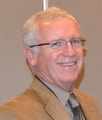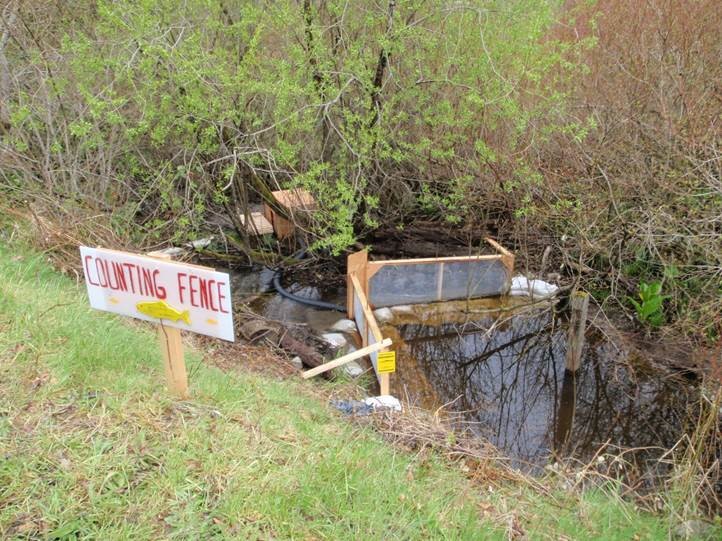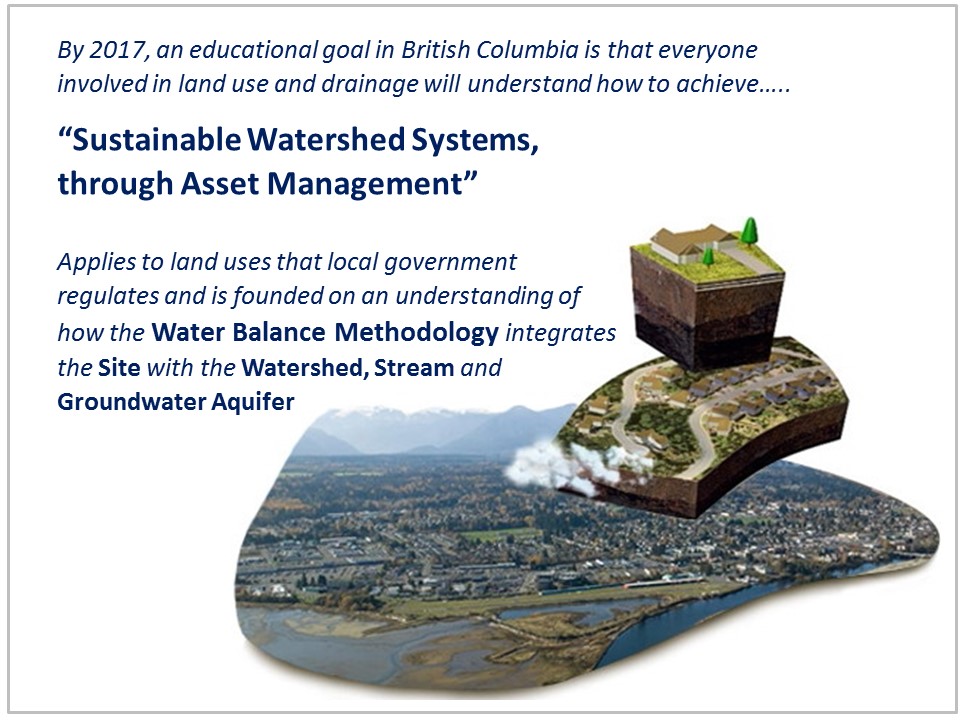“Sustainable Watershed Systems, through Asset Management” – local stream stewardship volunteers may yet be the difference-maker
Note to Reader:
A ‘whole-system, water balance’ approach to watershed protection and restoration recognizes the value of streams in their natural state. The approach is a call for balanced action: maintain the ecological values of nature’s assets, while allowing a stream to be used for drainage.
In a perfect world, within the built environment and with the foregoing premise as a starting point for land use and conservation decisions, communities would simply refocus business processes to properly manage watershed systems.
In practice, however, “getting it right” takes perseverance and time. Past BC history shows that local stream stewardship volunteers could play a defining role to make the community’s case for whole-system, water balance practices.
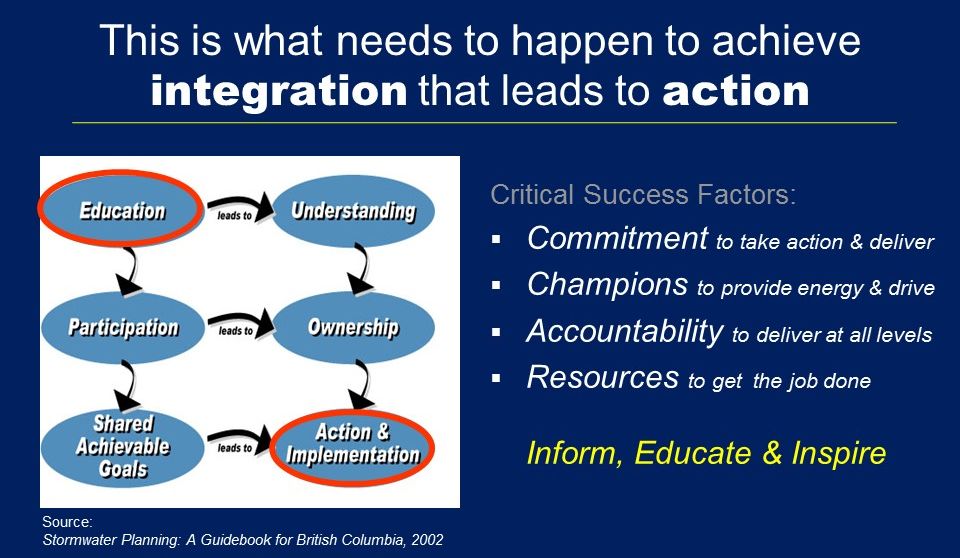
Informed decision-making is founded on a “sharing & learning” process that focusses on working towards a desired and desirable outcome
“The scope of involvement and influence of local stream stewardship volunteers is expanding beyond the creek channel,” states Peter Law
Under the umbrella of the Georgia Basin Inter-Regional Education Initiative, the Partnership for Water Sustainability in British Columbia is collaborating with provincial agencies, local governments, the stewardship sector and others to nurture a common understanding of what Sustainable Watershed Systems, through Asset Management would look like.
In BC, this is the branding for a water-resilient future that would be achieved through a whole-system, water balance approach. This builds on the vision for Asset Management for Sustainable Service Delivery: A BC Framework. It would integrate natural systems thinking and adaptation to a changing climate into asset management.
What Gets Measured Can Be Managed:
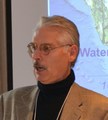 “To protect watershed health, engineered infrastructure ought to fit into natural systems, rather than the other way around,” states Tim Pringle, Chair, Ecological Accounting Protocol Initiative.
“To protect watershed health, engineered infrastructure ought to fit into natural systems, rather than the other way around,” states Tim Pringle, Chair, Ecological Accounting Protocol Initiative.
“If natural assets and derived service variables are not measured, they will not be managed in the context of drainage. The purpose of the Ecological Accounting Protocol is to help practitioners calculate the opportunity costs.”
Below, a flashback to the 1990s salmon crisis sets the scene for introductions to three noteworthy stewardship sector initiatives, representing three regions within the Georgia Basin: Nanaimo, Comox Valley and Metro Vancouver. All are motivated by a higher purpose.
To Learn More:
Download companion articles published in the Winter 2017 issue of the Asset Management BC Newsletter.
The first article takes stock of the outreach program in 2016 for Sustainable Watershed Systems to create awareness among an array of audiences by making presentations in a variety of forums and media.
The second is a progress report on the ongoing development of the Ecological Accounting Protocol (EAP) by the Partnership for Water Sustainability in BC.
Historical Context: Outcomes of BC Salmon Crisis
Ripple through Time
“Throughout British Columbia, salmon enhancement stewardship groups were formed in the 1990s as a response to the Coho salmon crisis,” recalls Peter Law, a founding Director of the Partnership for Water Sustainability. Prior to retiring from government, he was a regional fish biologist for Vancouver Island with the BC Ministry of Environment.
“Many of these volunteer groups had their beginnings in small stream salmon enhancement projects. From (salmon egg) incubation boxes to habitat restoration, they have partnered with fisheries agencies to restore salmonid populations. More than two decades later, most community-based groups still exist, providing thousands of volunteer hours to restore aquatic habitats.”
“These groups have monitored ‘local’ fish populations with traps and fences to measure success. In the past decade, a new focus on stream habitat monitoring and restoration has been implemented with the assistance of funding agencies like the Pacific Salmon Foundation.
“As we learn more about what influences early salmon life history, stewardship groups are asking questions of their local governments about the linkages between small stream habitat destruction and land developments. Now, the scope of their involvement and influence is expanding beyond the creek channel.”
“An outstanding example is the Mid-Vancouver Habitat Enhancement Society. The MVIHES coordinates efforts between agencies, private landowners and community volunteers in rebuilding salmon and their habitats in the Englishman River watershed.”
“Looking ahead, an informed stewardship sector may prove to be the difference-maker that accelerates implementation of the whole-system approach. Wouldn’t it be great if everyone really understood what it means to think and act like a watershed,” asks Peter Law rhetorically.
Defining a Role for the Stewardship Community:
“The stewardship community can work with local governments to inform the broader community. We can open eyes and minds. We can open doors so that together we can make the changes necessary to achieve a vision for a watershed,” adds ZoAnn Morten, Executive Director, Pacific Streamkeepers Foundation.
 “It is the streamkeepers who have the on-the-ground knowledge needed to establish restoration priorities within a watershed. That is the key to benefitting from local input.”
“It is the streamkeepers who have the on-the-ground knowledge needed to establish restoration priorities within a watershed. That is the key to benefitting from local input.”
“Once the consultants have gone home, only the community can take the vision for a watershed forward.”
Nanaimo Region: Shelly Creek Water Balance Strategy
The MVIHES is spearheading a creek case study that applies a whole-system, water balance approach. The plan is to develop a watershed restoration strategy.
“Shelly Creek is a small urban/rural tributary of the Englishman River north of Nanaimo. It is undergoing significant channel erosion due to urbanization. Alteration of the landscape has changed the three pathways by which rainfall reaches the stream, and how quickly it gets there,” states Peter Law.
“The MVIHES brought together partner agencies to co-fund development of a community-driven strategy for water balance restoration on the surrounding landscape. Implementing the strategy will be the hard part. Our shared challenge is to inform, educate and engage the broader community in a way that is meaningful, and results in action.”
Comox Valley: Eco-Asset Symposium –
Discovering Nature’s Infrastructure
On March 14-15, the 22 environmental and ratepayer groups comprising the Comox Valley Conservation Partnership are hosting a symposium on the potentially powerful and cost-effective role that ecosystem services can play in an infrastructure strategy.
 “The stewardship and conservation sector has traditionally focused on habitat restoration and protection of lands with high ecological values,” states David Stapley, Program Manager. “With cumulative impacts from climate change, urban and resource development escalating, these groups have now become community leaders in educating and supporting improved land use practices.”
“The stewardship and conservation sector has traditionally focused on habitat restoration and protection of lands with high ecological values,” states David Stapley, Program Manager. “With cumulative impacts from climate change, urban and resource development escalating, these groups have now become community leaders in educating and supporting improved land use practices.”
“To address these escalating challenges, the Eco-Assets Symposium will promote measures that capture the value of ecological assets to address infrastructure and climate change issues by integrating them into land use planning and practice.”
North Vancouver: Stormwater Impacts Communities and Creeks – What Can We Do?
On March 18, the North Shore Streamkeepers group is hosting a workshop for community leaders and groups from around the Metro Vancouver region.
“Our objective is to raise awareness about ways to better manage rainwater runoff, maintain stream health and support watershed-based plans,” reports Barbara  Frisken, President of the North Shore Streamkeepers.
Frisken, President of the North Shore Streamkeepers.
“The workshop will introduce community members to a vision for Sustainable Watershed Systems and what it means to value watersheds as infrastructure elements. Breakout groups will then be asked to identify possible community actions that can support a sustained focus on improving watersheds.


